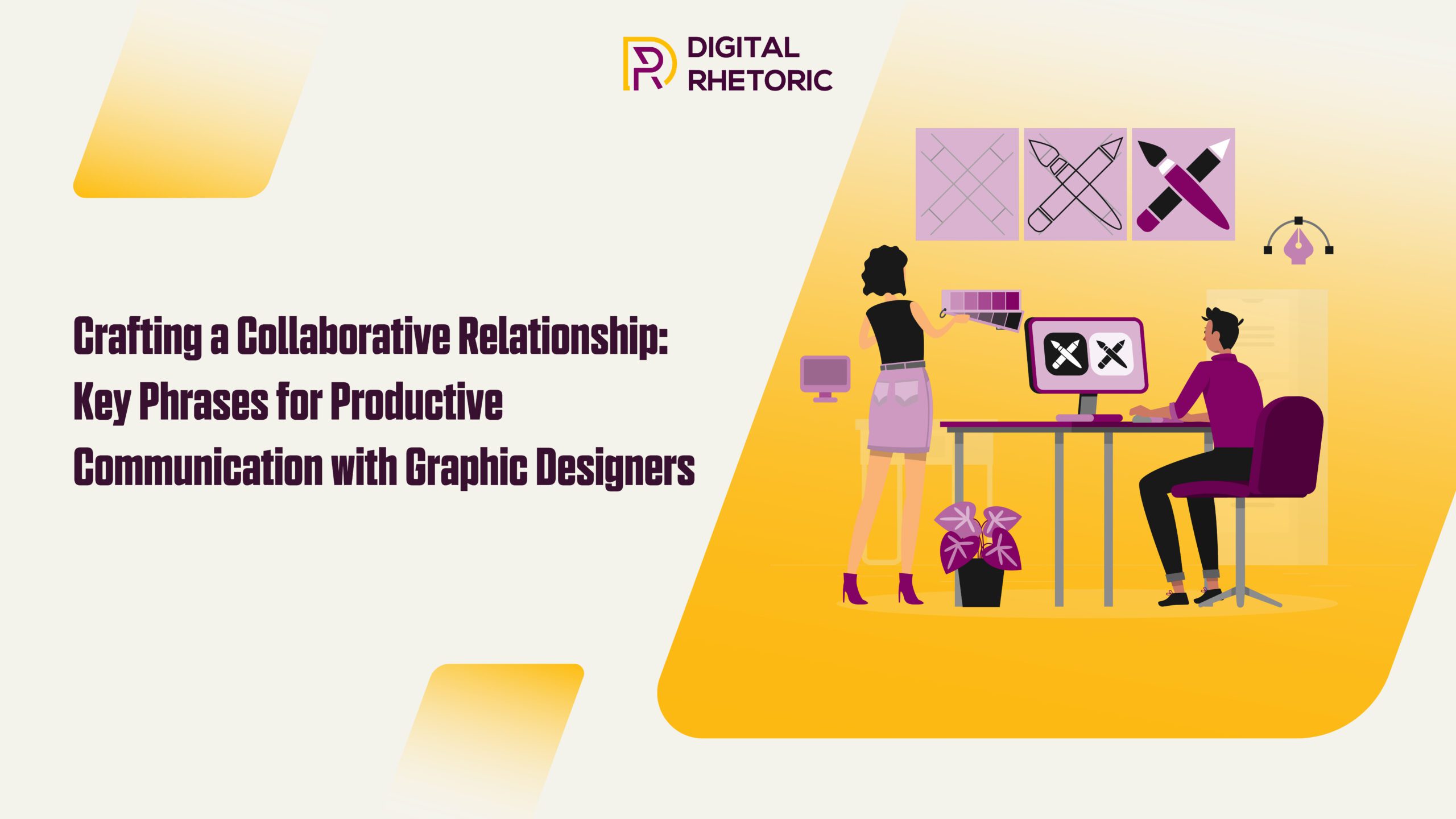Crafting a Collaborative Relationship: Key Phrases for Productive Communication with Graphic Designers
- Sanjay Thakore
- September 21, 2023
- Blog
- Digital Marketing Agency, Digital Marketing Company, Digital Marketing Services, Search Engine Optimization, SEO Services, Social Media Marketing Services
- 0 Comments

Effective communication between clients and graphic designers is the cornerstone of successful design projects. It is the bridge that connects creativity with expectations, and the conduit through which ideas are transformed into visual realities. In the world of graphic design, where the visual language speaks volumes, the ability to convey thoughts, preferences, and feedback is paramount. Without a doubt, collaborative communication fosters a harmonious working relationship and ensures that the end product aligns with the client’s vision. This blog explores the key phrases and approaches that can transform client-designer interactions into productive, respectful, and results-driven collaborations. It’s time to unlock the secrets of crafting a truly collaborative relationship with your graphic designer.
In the realm of effective communication tips and graphic design collaboration strategies, one fundamental aspect stands out: the design brief. It’s the compass that guides the creative journey, the roadmap that ensures everyone is on the same page, and the foundation upon which a successful project is built.
The Significance of a Clear and Detailed Design Brief
Imagine embarking on a road trip without a map or destination in mind. Chances are, you’ll end up lost, frustrated, and far from your intended goal. Similarly, in the world of graphic design collaboration, a vague or incomplete design brief can lead to confusion, misalignment, and a less-than-optimal outcome.
A well-crafted design brief is more than just a document; it’s a communication tool. It serves as the vital link between the client’s vision and the designer’s creativity. Here’s why it’s so crucial:
- Alignment of Vision: A clear brief articulates the client’s objectives, expectations, and desired outcomes. It ensures that both parties are on the same page from the outset.
- Guidance for Creativity: Designers thrive on creative freedom, but they need a starting point. A detailed brief provides the necessary guidance while allowing room for innovative interpretation.
- Efficiency: It streamlines the design process, minimizing the need for extensive revisions and iterations. This saves time and resources for both the client and the designer.
- Preventing Misunderstandings: Clarity in the brief reduces the risk of misunderstandings and miscommunications. It’s a proactive measure to address potential pitfalls.
- Measurable Success: A well-defined brief establishes clear project objectives and success criteria. This enables both parties to measure the project’s effectiveness against predetermined goals.
In essence, the design brief is the compass that ensures the project stays on course, the communication tool that fosters understanding, and the blueprint that guides the creative journey. It’s an invaluable component of effective communication in graphic design collaboration, setting the stage for a productive and successful project.
Respectful Feedback:
Constructive and respectful feedback is an art that enhances the dynamic between clients and graphic designers. A positive and considerate tone in feedback not only ensures the message is received well but also nurtures a collaborative and productive working relationship. It’s essential to focus on specific aspects, articulate what works, and suggest improvements rather than criticize. When feedback is framed in a constructive manner, it fosters an atmosphere of mutual respect, encourages open dialogue, and ultimately leads to a design that aligns more closely with the client’s vision. In the realm of effective communication, a little positivity goes a long way in achieving exceptional results.
Open Dialogue:
Encouraging open and honest communication in client-designer collaborations offers numerous benefits:
- Clarity: Open dialogue ensures everyone understands the project’s goals and requirements clearly.
- Alignment: Discussing ideas and expectations openly helps align the creative direction with the client’s vision.
- Feedback Loop: It creates a continuous feedback loop, allowing for real-time adjustments and improvements.
- Problem-Solving: Openness fosters the ability to address concerns promptly and find practical solutions.
- Enhanced Creativity: Free expression of ideas fuels creativity and leads to innovative design solutions.
- Trust Building: It builds trust and rapport, strengthening the working relationship between client and designer.
- Efficiency: Efficient communication minimizes misunderstandings, reducing the need for revisions and project delays.
- Client Satisfaction: An open dialogue ensures the client’s needs and preferences are consistently met, enhancing overall satisfaction.
Asking Questions:
Asking questions to clarify doubts or uncertainties is a fundamental aspect of effective communication in graphic design collaborations. It serves as a proactive measure to prevent misunderstandings and ensures that both the client and designer are on the same wavelength. When questions are asked, it demonstrates a commitment to mutual understanding and attention to detail. It allows for the clarification of preferences, expectations, and project specifics, leaving little room for assumptions or misinterpretations. Ultimately, this open and inquisitive approach paves the way for a smoother and more successful design project, where clarity reigns supreme, and miscommunication takes a backseat.
Appreciation:
Expressing appreciation and acknowledging the designer’s efforts is a crucial aspect of maintaining a positive and productive client-designer relationship. Designers invest their creativity, skills, and time to bring a client’s vision to life. Acknowledging this dedication not only shows gratitude but also motivates the designer to go the extra mile. It fosters mutual respect and a sense of partnership. Whether it’s a simple “thank you” or a more comprehensive acknowledgment of the designer’s contributions, it goes a long way in creating a harmonious collaboration. Ultimately, this appreciation ensures that the design process remains not only professional but also personally rewarding for both parties.
Timely Responses:
The significance of timely responses to emails or messages cannot be overstated in graphic design collaborations. Delays in communication can have a cascading effect, hindering project progress in several ways:
- Efficiency: Timely responses keep the project on track, ensuring that design phases progress smoothly and according to schedule.
- Clarification: Rapid responses allow for quick clarification of doubts or uncertainties, preventing misunderstandings that could lead to revisions.
- Feedback Loop: A prompt reply enables an efficient feedback loop, facilitating real-time adjustments and improvements.
- Client Satisfaction: It demonstrates professionalism and a commitment to the project, enhancing client satisfaction.
- Resource Management: Efficient communication minimizes resource wastage by preventing unnecessary delays and revisions.
In graphic design, where timelines are often tight, responsive communication is a linchpin for project success. Clients and designers alike should prioritize timely responses to ensure that the creative process flows seamlessly and that project milestones are met.
Managing Expectations:
Setting realistic expectations in graphic design collaborations is paramount for a harmonious working relationship and successful project outcomes. It ensures that both the client and the designer have a shared understanding of what can be achieved within the given timeline and budget. Realistic expectations prevent disappointment, reduce stress, and promote a sense of trust and transparency. Moreover, it allows for a more accurate assessment of project progress and ensures that the final design aligns with the initial vision. By aligning expectations with reality, clients and designers can collaborate effectively and achieve results that meet or exceed their goals.
Flexibility:
Encouraging clients to be open to revisions and design tweaks is a key aspect of productive graphic design collaborations. Flexibility in the creative process allows for exploration, refinement, and the pursuit of excellence. It acknowledges that design is an iterative journey where adjustments can lead to a more refined and polished final product. Embracing revisions as opportunities for improvement fosters a dynamic partnership between client and designer. It ensures that the design aligns more closely with the client’s vision and goals, ultimately resulting in a final product that not only meets expectations but exceeds them in terms of quality and effectiveness.
Conclusion
The essence of a successful graphic design collaboration lies in fostering a collaborative partnership. Clients and graphic designers are not separate entities but integral components of a unified team working towards a shared goal. This partnership thrives on effective communication, open dialogue, mutual respect, and a commitment to understanding and embracing each other’s perspectives. By working hand in hand, clients and designers can harness their collective creativity and expertise to bring visions to life. It’s not merely a transactional relationship but a collaborative journey where both parties contribute their strengths, resulting in designs that are not only visually captivating but also strategically impactful. Together, they transform ideas into remarkable realities.
As you embark on your creative endeavors and collaborate with graphic designers, remember that effective communication is your greatest asset. Apply these key phrases and principles to your interactions for more productive and successful collaborations. By doing so, you’ll not only enhance the quality of the design projects but also nurture a more harmonious working relationship. For further insights and tools to elevate your graphic designer collaborations, visit https://digitalrhetoric.in/. Here, you’ll discover valuable resources and strategies to optimize your journey in working with graphic designers. Embrace the power of effective communication, and watch your creative visions come to life.

